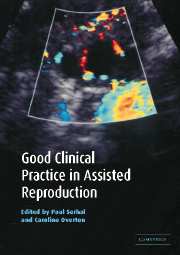Book contents
- Frontmatter
- Contents
- List of contributors
- Foreword by Bob Edwards
- Preface
- 1 Clinical assessment of the woman for assisted conception
- 2 Clinical assessment and management of the infertile man
- 3 Laboratory assessment of the infertile man
- 4 Donor insemination
- 5 Treatment options prior to IVF
- 6 Strategies for superovulation for IVF
- 7 Techniques for IVF
- 8 Ovarian hyperstimulation syndrome
- 9 Early pregnancy complications after assisted reproductive technology
- 10 Oocyte donation
- 11 Surrogacy
- 12 Clinical aspects of preimplantation genetic diagnosis
- 13 Controversial issues in assisted reproduction
- 14 Alternatives to in vitro fertilization: gamete intrafallopian transfer and zygote intrafallopian transfer
- 15 Counselling
- 16 Good nursing practice in assisted conception
- 17 Setting up an IVF unit
- 18 Information technology aspects of assisted conception
- 19 Assisted reproductive technology and older women
- 20 Ethical aspects of controversies in assisted reproductive technology
- Index
- Plate section
10 - Oocyte donation
Published online by Cambridge University Press: 22 October 2009
- Frontmatter
- Contents
- List of contributors
- Foreword by Bob Edwards
- Preface
- 1 Clinical assessment of the woman for assisted conception
- 2 Clinical assessment and management of the infertile man
- 3 Laboratory assessment of the infertile man
- 4 Donor insemination
- 5 Treatment options prior to IVF
- 6 Strategies for superovulation for IVF
- 7 Techniques for IVF
- 8 Ovarian hyperstimulation syndrome
- 9 Early pregnancy complications after assisted reproductive technology
- 10 Oocyte donation
- 11 Surrogacy
- 12 Clinical aspects of preimplantation genetic diagnosis
- 13 Controversial issues in assisted reproduction
- 14 Alternatives to in vitro fertilization: gamete intrafallopian transfer and zygote intrafallopian transfer
- 15 Counselling
- 16 Good nursing practice in assisted conception
- 17 Setting up an IVF unit
- 18 Information technology aspects of assisted conception
- 19 Assisted reproductive technology and older women
- 20 Ethical aspects of controversies in assisted reproductive technology
- Index
- Plate section
Summary
To women traditionally considered irreversibly sterile due to ovarian failure, oocyte donation and exogenous steroid replacement to create an endometrial milieu receptive to embryonic implantation offers the prospect of achieving a successful pregnancy. Irrespective of the age of the oocyte recipient, it is possible to achieve a high fertility potential with a low miscarriage rate, reflecting the improved biological performance of oocytes obtained from young donors. It is now feasible to dissociate the stages of embryonic development and endometrial maturation in oocyte recipients. Hence, oocyte donation can provide insights into as yet unresolved questions, such as the duration of the ‘implantation window’ in humans. In human reproduction, oocyte donation undoubtedly complements basic IVF in elucidating the biological interactions between the conceptus, endometrium and steroid environment.
In 1983, Trounson et al. reported the first successful transfer of an in vitro fertilized donated oocyte embryo to a menstrually cyclic recipient using luteinizing hormone (LH) synchronization between the donor and the recipient to time the transfer. In 1984, Lutjen et al. reported the first successful pregnancy in a primary ovarian failure patient, following a sequential steroid replacement regimen and transfer of in vitro fertilized donated oocyte embryos. In 1983, Buster et al. reported the successful transfer of an in vivo fertilized donated ovum. In 1986, Serhal and Craft introduced the notion that women older than 40 years who have already entered the menopause might extend their reproductive potential through oocyte donation. Oocyte donation is a well-established technique and a large proportion of IVF units now run oocyte donation programs.
Keywords
- Type
- Chapter
- Information
- Good Clinical Practice in Assisted Reproduction , pp. 186 - 198Publisher: Cambridge University PressPrint publication year: 2004

